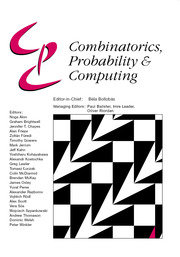Article contents
On Komlós’ tiling theorem in random graphs
Published online by Cambridge University Press: 25 July 2019
Abstract
Given graphs G and H, a family of vertex-disjoint copies of H in G is called an H-tiling. Conlon, Gowers, Samotij and Schacht showed that for a given graph H and a constant γ>0, there exists C>0 such that if  $p \ge C{n^{ - 1/{m_2}(H)}}$, then asymptotically almost surely every spanning subgraph G of the random graph 𝒢(n, p) with minimum degree at least
$p \ge C{n^{ - 1/{m_2}(H)}}$, then asymptotically almost surely every spanning subgraph G of the random graph 𝒢(n, p) with minimum degree at least  $\delta (G) \ge (1 - \frac{1}{{{\chi _{{\rm{cr}}}}(H)}} + \gamma )np$
$\delta (G) \ge (1 - \frac{1}{{{\chi _{{\rm{cr}}}}(H)}} + \gamma )np$ $\gamma {(C/p)^{{m_2}(H)}}$ vertices, which is strictly smaller when
$\gamma {(C/p)^{{m_2}(H)}}$ vertices, which is strictly smaller when  $p \ge C{n^{ - 1/{m_2}(H)}}$. In the case where H = K3, this answers the question of Balogh, Lee and Samotij. Furthermore, for an arbitrary graph H we give an upper bound on p for which some leftover is unavoidable and a bound on the size of a largest H -tiling for p below this value.
$p \ge C{n^{ - 1/{m_2}(H)}}$. In the case where H = K3, this answers the question of Balogh, Lee and Samotij. Furthermore, for an arbitrary graph H we give an upper bound on p for which some leftover is unavoidable and a bound on the size of a largest H -tiling for p below this value.
Information
- Type
- Paper
- Information
- Copyright
- © Cambridge University Press 2019
References
- 4
- Cited by

